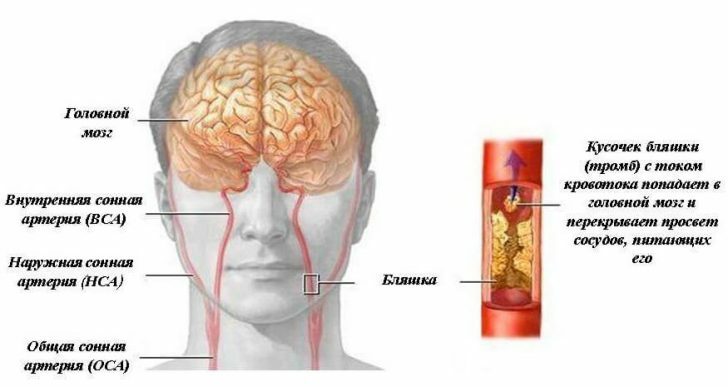Intracranial hypertension
 Intracranial hypertension is a pathological change in the brain caused by an increase in the pressure gradient with which the CSF moves along the conducting pathways. Intracranial hypertension is widespread and has a very negative effect on all brain structures. Usually, this pathology is a secondary syndrome that occurs against the background of the influence of some factor, for example traumatic nature. According to the world statistics of pathologies of a neurological nature, intracranial hypertension is more affected by men, although in childhood this pathology occurs equally often among both sexes.
Intracranial hypertension is a pathological change in the brain caused by an increase in the pressure gradient with which the CSF moves along the conducting pathways. Intracranial hypertension is widespread and has a very negative effect on all brain structures. Usually, this pathology is a secondary syndrome that occurs against the background of the influence of some factor, for example traumatic nature. According to the world statistics of pathologies of a neurological nature, intracranial hypertension is more affected by men, although in childhood this pathology occurs equally often among both sexes.
It should be borne in mind that the pathomorphological substrate of intracranial hypertension can act not only an intracerebral fluid, but also blood, tissue fluid and even a tumor substrate.
Causes of intracranial hypertension
Before understanding the causes of increased intracranial pressure, one should consider the normal physiology of CSF motion. Under normal conditions, the entire brain tissue is surrounded by cerebrospinal fluid, which is in a closed space( cranium) under certain pressure. Intracerebral fluid or liquor is constantly in a moving state, and its movement occurs at a certain rate. The process of renewal of the cerebrospinal fluid is its production, circulation and absorption into the bloodstream, and these processes occur constantly with a certain regularity.
In a situation where there is an excessive accumulation of cerebrospinal fluid, which may be due to a violation of its absorption or in contrast to an increase in the activity of its products, there is an increase in the pressure gradient that the cerebrospinal fluid exerts on the structures of the brain. In addition, there is another pathogenetic mechanism for the development of intracranial hypertension, consisting in the violation of the patency of the ways of circulation of the intracerebral fluid, which is extremely rare.
Unfortunately, not all situations even expressed intracranial hypertension have an obvious provoking etiologic factor, and the treating physician has to more carefully verify the cause of increased intracranial pressure. With the harmful effects of this or that provoking factor, the mechanisms of development of intracranial hypertension can be very different. Thus, with the available volumetric formation in the brain, an example of which may serve as posthemorrhagic hematoma or tumor conglomerate, a compression effect on the structures of the brain develops. As a compensatory mechanism in this situation, there is expressed or moderate intracranial hypertension, which is distinguished by a progressive course.
Intracranial hypertension in the infants most often develops as a result of hydrocephalus, which occurs for various reasons( prolonged intrauterine fetal hypoxia, intrauterine infection of the fetus with infectious agents of the neurogroup).To a greater extent this pathology affects newborn babies born before the expected time.
In the adult category of patients, intracranial hypertension develops in almost any pathological condition, which is accompanied by the development of even a minimal edema of the brain tissue, for example, posttraumatic effect, infectious damage to the meninges, etc.
There is a range of chronic diseases that can serve as a background for the development of signs of intracranial hypertension, among which there is congestive heart failure and the presence of effusion in the pericardial bag. In a situation where the increase in the pressure gradient of the intracerebral fluid has a long and pronounced character, the compensatory expansion of the fluid cavities of the brain occurs, which is called "hydrocephalus".Of course, this condition allows for some time to eliminate the manifestation of intracranial hypertension, but it should be borne in mind that the dilatation of the brain cavities occurs simultaneously with the atrophy of the main mass of the brain, which has a very negative effect on its functions.
Symptoms and signs of intracranial hypertension
Symptomocomplex of intracranial hypertension includes a rather wide range of clinical manifestations, therefore in each patient this pathology can proceed quite differently. In addition, the degree of increase in the pressure gradient in the cranium is of great importance with respect to the development of clinical symptoms. The most common symptom of intracranial hypertension is the pain syndrome in the head region of varying degrees of intensity. Pathognomonic sign is the appearance of heaviness and severe pain syndrome of a widespread character in the head during the night period of the day, which has its pathogenetic explanation( in the supine position, a strong development of cerebrospinal fluid accompanied by a slowing down of the absorption of cerebral fluid is observed).
At the peak of increased intracranial pressure, the patient is concerned about severe nausea and vomiting, and these pathological conditions have nothing to do with eating the day before. Even after vomiting, the condition of patients does not change for the better, which is also a pathognomonic sign of intracranial hypertension.
Light intracranial hypertension, under the condition of its prolonged course, violates the psychoemotional balance of a person, which is manifested in increased excitability, flashes of irritability and rapid fatigue even without the presence of heavy physical exertion.
Specialists in the field of neurology note that for patients with intracranial hypertension, the presentation of complaints characteristic of vegetative-vascular dystonia is manifested, manifested in the form of a sharp change in blood pressure, increased sweating, a feeling of rapid heart rate and short-term loss of consciousness.
A remarkable objective clinical criterion of intracranial hypertension is the appearance of "bruises" in the projection of the paraorbital region, which are not eliminated by cosmetic means. Since the skin in the eyelid region is very thin, an enlarged venous network appears through it, which is a cosmetic defect and brings discomfort to female representatives.
The periods of exacerbations of intracranial hypertension have a clear correlation dependence on changes in the weather conditions of the environment in which the person suffering from this pathology is. In connection with this fact, intracranial hypertension can be attributed to the category of meteorological pathology.
In some situations, chronic intracranial hypertension in patients marked a sharp decrease in sexual desire to the opposite sex, which can also be regarded as a clinical marker of this pathology, which allows to correctly verify the diagnosis.
The peculiarity of the course of intracranial hypertension in infants is a long latent period, during which the parents do not notice the presence of any symptoms that allow one to suspect the presence of this pathology in the child. This feature is explained by the imperfection of the skull bone in a child( non-healing of sutures and fontanelles).However, with a marked increase in the gradient of intracranial pressure, the child observes the appearance of a whole range of specific clinical signs in the form of a piercing cry, a sharp swelling of the skin above the fontanel with a characteristic pulsation, increased convulsive readiness, vomiting and various degrees of impaired consciousness. Attentive parents in the period of increased intracranial pressure note a change in behavioral reactions in the child, which manifests itself in the rapid change of expressed anxiety on lethargy and lack of mobility.
Despite all the diversity and pathognomonic clinical manifestations of intracranial hypertension, it is possible to reliably establish the correct diagnosis to neurologists only after using the instrumental methods of patient research. Currently, the most reliable and at the same time safe for the patient's study, allowing to establish a diagnosis even at an early stage of development of intracranial hypertension, is magnetic resonance imaging. However, there is a whole range of minimally invasive procedures, thanks to which it is possible to recognize the indirect criteria of intracranial hypertension, which include examination of the fundus, ultrasound Doppler study of cerebral vessels and echoencephalography.
Clinical criterion of intracranial hypertension when examining the fundus is the detection of pathological enlargement and pronounced crimp venous vessels. When performing magnetic resonance imaging in a patient with intracranial hypertension, in almost 100% of cases an expansion of the fluid cavities of the brain with simultaneous thinning or dilution of the underlying cerebral substance is detected. Intracranial venous hypertension is well diagnosed using the Doppler study of cerebral vessels, in which there is a significant decrease in the venous blood flow.
Benign intracranial hypertension
In its practical activities, not only neurologists, but also specialists of other profiles often encounter cases of benign intracranial hypertension, which is regarded not as a disease, but as a compensatory mechanism observed in different physiological states. In some neurological aids, this variant of intracranial hypertension is treated as a "false brain tumor".A group of risk for benign intracranial hypertension are women of young age who are overweight.
The peculiarity of this pathogenetic form of intracranial hypertension is the reversibility of its manifestations, as well as a latent favorable course. Typically, the establishment of a benign or idiopathic form of intracranial hypertension occurs when neither the specialists nor the patient himself is able to recognize the etiological factor that triggered her development. In children's age category, benign intracranial hypertension most often develops after improperly abolishing glucocorticosteroid preparations, and as a side effect of prolonged use of antibacterial drugs of the tetracycline group.
The debut of benign intracranial hypertension consists in the periodic appearance of a mild pain syndrome in the head, which is quickly stopped by the administration of any analgesic drug, or completely passes by itself. At this stage, patients almost never seek medical help.
Over time, clinical manifestations in the form of a pain syndrome in the head become more aggressive and attacks of such pain are increasingly causing a prolonged disorder of the state of human health. The character of a headache with a benign variant of intracranial hypertension is described by patients as a diffuse "raspiranie" in the head with maximum concentration in the paraorbital and frontal regions. A characteristic feature of the pain syndrome is the intensification of its intensity with the tilt of the head and cough movements of the diaphragm. With a sharp change in the position of the body in space, patients often notice dizziness, nausea and even vomiting.
The fundamental link in the development of a program for managing and treating a patient with a benign form of intracranial hypertension is a modification of his lifestyle, which consists in developing an individual diet that reduces weight. Drugs of the diuretic series are used only in the case of a marked increase in intracranial pressure, and the drug of choice in this situation is Diacarb in a single dose of 250 mg orally.
Treatment of intracranial hypertension
Increased intracranial pressure provokes not only the development of bright clinical symptoms, which has a very negative effect on the patient's well-being, but can also provoke the development of serious complications right up to a lethal outcome. In this regard, the use of medication and non-therapeutic measures is the main task with intracranial hypertension. The consequences of intracranial hypertension, subject to the complete absence of therapeutic measures, can be the most severe in the form of a decrease in intellectual-mnestic capabilities, a violation of the nervous regulation of internal organs, hormonal imbalance.
Not medicinal methods of therapy can be used even at the stage of incomplete verification of the diagnosis, and they consist in the normalization of the drinking regime, the performance of special exercises of physiotherapy exercises and the application of physiotherapy techniques.
The basis of the pathogenetic orientation of therapy of intracranial hypertension consists of drugs whose effect is directed to a simultaneous decrease in the production of cerebrospinal fluid and intensification of the process of absorption of the cerebrospinal fluid. The gold standard in this role is the regimen used for diuretic therapy. The drug of choice in eliminating the signs of intracranial hypertension at the stage of development of hydrocephalus is Diacarb in an effective therapeutic dose of 250 mg, the pharmacological action of which is aimed at reducing the production of cerebrospinal fluid.
In a situation where even prolonged use of drugs diuretic pharmacological series does not have the proper effect in the form of relief of clinical manifestations and normalization of indicators of instrumental examination methods, it is advisable to prescribe glucocorticosteroid drugs( Dexamethasone in the initial daily dose of 12 mg).In severe intracranial hypertension, neurologists use pulse therapy consisting of parenteral administration of Methylprednisolone 1000 mg per day for five days and subsequent switching to oral administration. This scheme, as a rule, is supplemented by the appointment of Diacarb in the usual therapeutic dose.
For the purpose of correction of venous intracranial hypertension, medicines are used that improve the outflow of venous blood from the brain, to which Troxevasin belongs in an average daily dose of 600 mg. As a symptomatic therapy of severe pain in the head, the use of drugs of the group of non-steroidal anti-inflammatory drugs( Nimid at an allowable maximum dosage of 400 mg) and anti-migraine agents( Antimigrene in a daily dose of not more than 200 mg) is allowed in the head.
With a pronounced increase in intracranial pressure, parenteral administration of hypertonic solutions( 400 ml of 20% mannitol solution) is permissible, the dehydrating action of which is realized by the method of dehydration of the brain substance, which limits their use.
In acute intracranial hypertension, the occurrence of which has a clear connection with the performance of a neurosurgical operation, the use of drugs of the barbiturate group is indicated( a single intravenous injection of Thiopental sodium at a dose of 350 mg).
If intracranial hypertension is characterized by a progressive malignant course and is not stopped by any medication, the patient should be surgically corrected for this pathological condition. The most common palliative method of surgical treatment with intracranial hypertension of any etiology is a lumbar puncture, by which a small amount of cerebrospinal fluid is mechanically removed( no more than 30 ml per manipulation).In some situations, lumbar puncture has a marked positive effect after its first application, but most often remission occurs only after several manipulations, which are carried out with a multiplicity of 1 time in two days.
A longer-term and more pronounced positive effect on the leveling of not only the manifestations but also the pathogenetic mechanisms of intracranial hypertension development is provided by the operational aid "lumbosuperitoneal shunting".As an operative treatment for visual disturbances that develop at a late stage of intracranial hypertension, decompression of the optic nerve shells is applied.
Intracranial hypertension - which doctor will help ?If there is or suspected the development of intracranial hypertension, you should immediately seek advice from such doctors as a neuropathologist and therapist.



